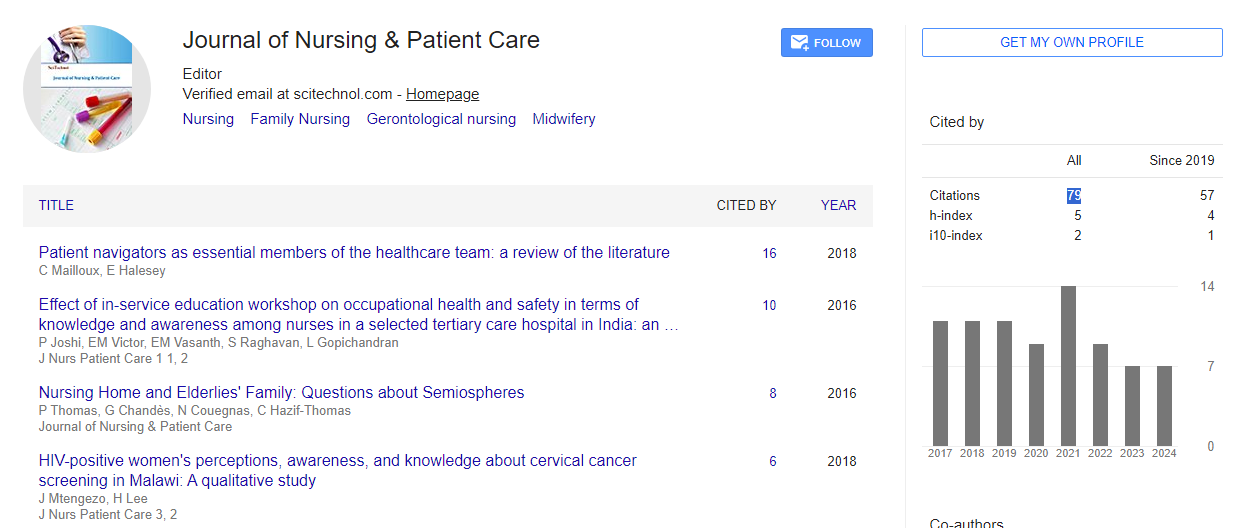Opinion Article, J Nurs Patient Care Vol: 9 Issue: 2
Critical Care Nursing for Patients with Multi-System Organ Failure
Pier Marth*
1Department of Nursing, University of Balearic Islands, Illes Balears, Spain
*Corresponding Author: Pier Marth,
Department of Nursing, University of Balearic
Islands, Illes Balears, Spain
E-mail: marthp@ier.sw
Received date: 28 May, 2024, Manuscript No. JNPC-24-140264;
Editor assigned date: 30 May, 2024, PreQC No. JNPC-24-140264 (PQ);
Reviewed date: 13 June, 2024, QC No. JNPC-24-140264;
Revised date: 21 June, 2024, Manuscript No. JNPC-24-140264 (R);
<br />Published date: 28 June, 2024, DOI: 10.4172/2573-4571.1000065.
Citation: Marth P (2024) Critical Care Nursing for Patients with Multi-System Organ Failure. J Nurs Patient Care 9:2.
Description
Multi-System Organ Failure (MSOF), also known as Multiple Organ Dysfunction Syndrome (MODS), is a severe, life-threatening condition often encountered in critical care settings. It involves the failure of two or more organ systems and represents a significant challenge in the field of critical care nursing. The management of patients with MSOF requires advanced knowledge, critical thinking, and a multidisciplinary approach.
MSOF is typically a consequence of systemic inflammation, often resulting from conditions like sepsis, trauma, or pancreatitis. The pathophysiology involves a complex interplay between the inflammatory response, immune dysregulation, and cellular injury. Inflammatory mediators, such as cytokines, are released in response to an insult, leading to widespread endothelial damage, increased vascular permeability, and organ dysfunction. For instance, in sepsis, the body's response to infection can lead to a cascade of events that result in compromised blood flow and oxygen delivery to organs. This can cause acute kidney injury, Acute Respiratory Distress Syndrome (ARDS), liver dysfunction, and cardiovascular instability. The progression of MSOF is dynamic, with the potential for rapid deterioration, necessitating prompt and effective intervention by the critical care team.
Continuous and meticulous monitoring is important for managing MSOF. Nurses play a pivotal role in early identification of changes in the patient’s condition through vigilant observation and interpretation of vital signs, laboratory results, and clinical indicators of organ function. Monitoring devices, such as arterial lines, central venous catheters, and pulmonary artery catheters, provide essential data on hemodynamic status, fluid balance, and oxygenation. Frequent assessments are necessary to detect subtle changes that may indicate worsening organ function. For example, a sudden drop in urine output could signal worsening kidney function, necessitating immediate intervention. In addition, serial lactate measurements can help gauge the severity of tissue hypoperfusion and guide resuscitation efforts.
Hemodynamic instability is common in patients with MSOF, often requiring interventions such as fluid resuscitation and vasoactive medications. Nurses are responsible for administering and titrating these therapies based on hemodynamic parameters and clinical response. The goal is to optimize cardiac output and perfusion to vital organs while avoiding fluid overload and secondary complications like pulmonary edema. Fluid management involves a careful balance, often guided by dynamic assessments of fluid responsiveness, such as pulse pressure variation or stroke volume variation. Vasoactive medications, such as norepinephrine or vasopressin, may be required to support blood pressure and maintain adequate perfusion pressure.
Respiratory failure is a common component of MSOF, frequently necessitating mechanical ventilation. Critical care nurses are involved in the management of ventilation strategies, including setting appropriate ventilator parameters, monitoring for complications like ventilator-associated pneumonia, and ensuring adequate oxygenation and ventilation. Strategies such as lung-protective ventilation and prone positioning may be employed to optimize oxygenation and minimize ventilator-induced lung injury. Renal dysfunction in MSOF may require Renal Replacement Therapy (RRT), such as Continuous Renal Replacement Therapy (CRRT) or intermittent hemodialysis. Nurses play a critical role in managing these therapies, including monitoring for complications, ensuring appropriate anticoagulation, and adjusting treatment parameters based on the patient’s fluid and electrolyte status.
Patients with MSOF are often in a hypermetabolic state, requiring careful nutritional support. Enteral nutrition is preferred when feasible, as it supports gut integrity and immune function. Nurses are responsible for monitoring nutritional intake, managing feeding tubes, and adjusting feeding regimens based on tolerance and metabolic demands. Infections are a major cause and complication of MSOF. Adherence to infection control practices, such as hand hygiene, aseptic technique, and surveillance cultures, is essential in preventing secondary infections. Nurses also play a key role in the timely administration of antibiotics and the management of any infectious complications.
Conclusion
Caring for patients with Multi-System Organ Failure in the critical care setting is an immensely complex and demanding task that requires a high level of skill, knowledge, and coordination. Through comprehensive monitoring, targeted interventions, and effective teamwork, critical care nurses play a vital role in managing the intricate challenges of MSOF. Their efforts contribute significantly to optimizing patient outcomes, minimizing complications, and supporting the holistic needs of both patients and their families in these critical moments.
 Spanish
Spanish  Chinese
Chinese  Russian
Russian  German
German  French
French  Japanese
Japanese  Portuguese
Portuguese  Hindi
Hindi 